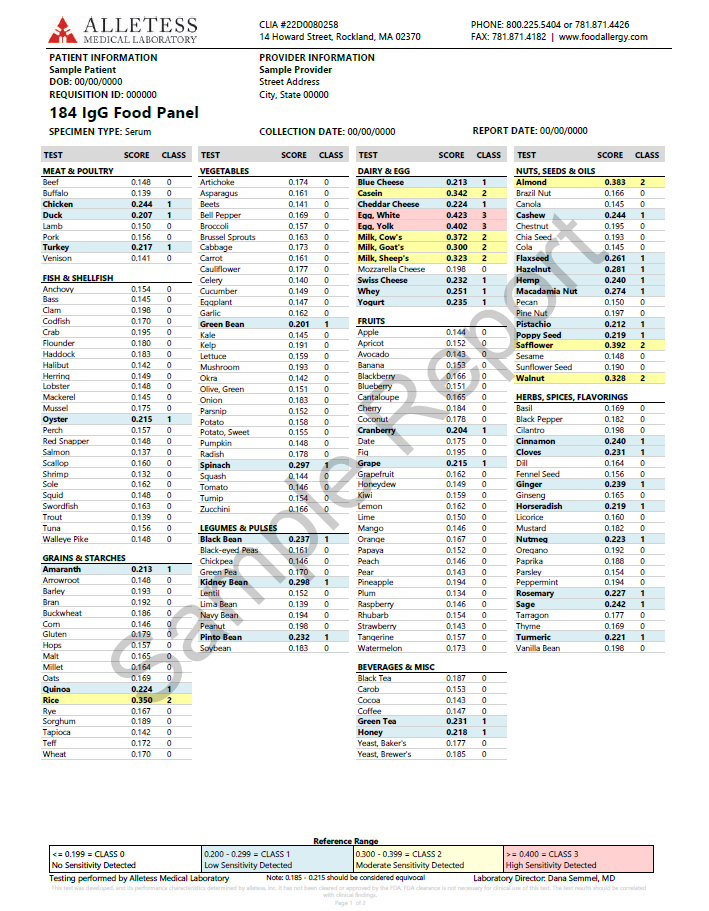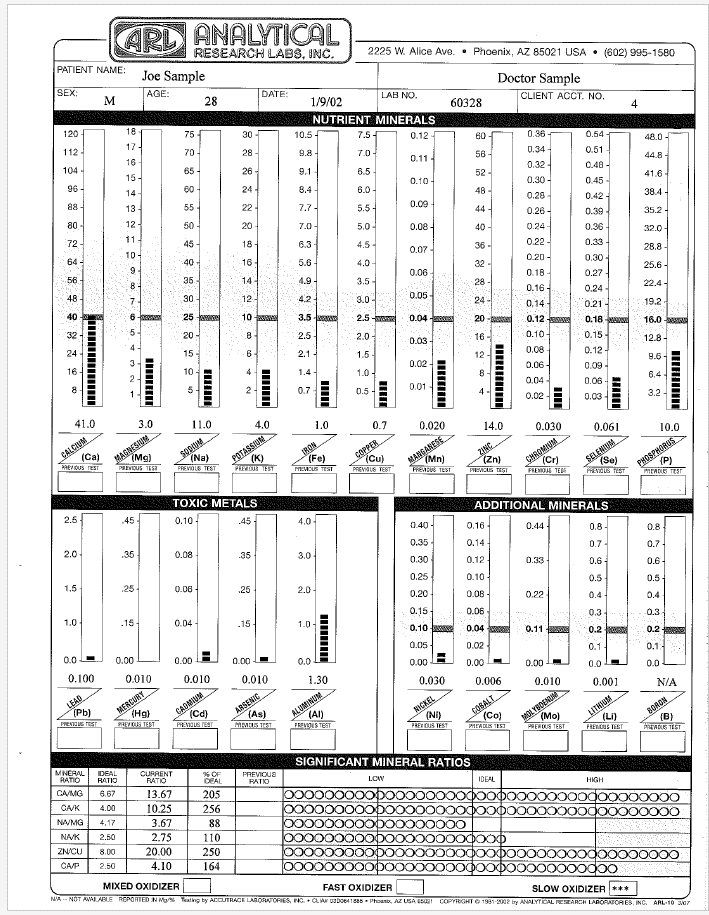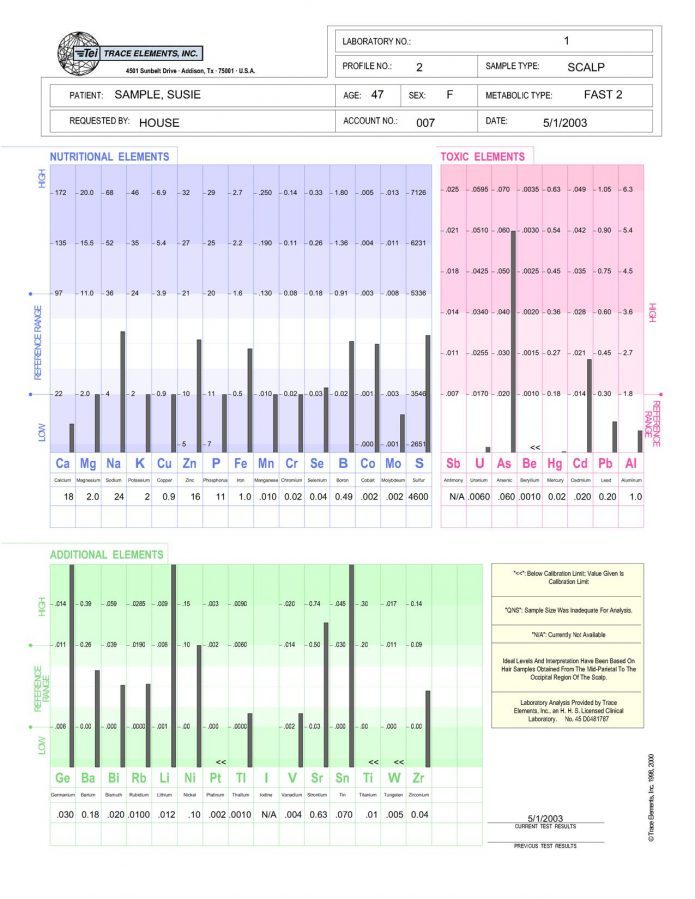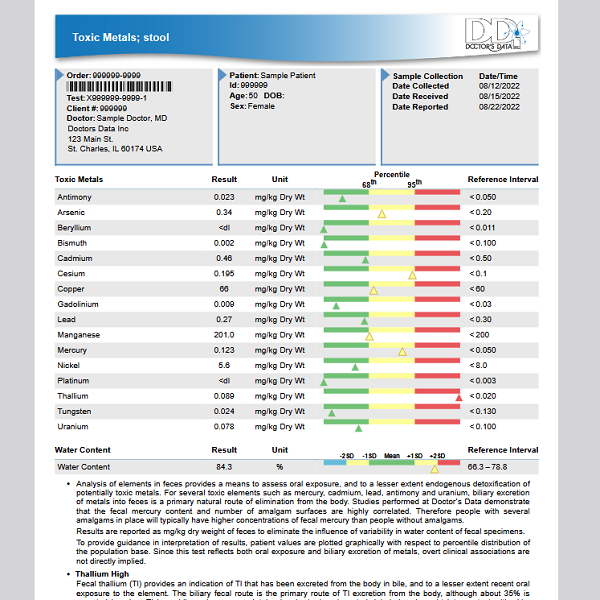
Table of Contents
Introduction
Understanding the intricate relationship between nutrition and behavior is becoming more crucial in today’s health-conscious society. There is a strong and noticeable correlation between nutrition and behavior, which provides insights into an individual’s mineral and heavy metal levels. Hair analysis can help identify and guide the correction of many cognitive, emotional and behavioral imbalances.
This article delves into what hair analysis is, its importance in assessing nutritional status, and how it relates to behavioral patterns. By examining these factors, readers can gain a deeper understanding of how minerals and heavy metals influence mental health and overall wellness.
What is Hair Analysis?
Hair analysis is a diagnostic tool that examines hair samples to assess the levels of various minerals and heavy metals in the body. Hair can reflect an individual’s nutritional status that affects behavior and environmental exposure over time. Unlike blood tests that capture a snapshot of nutrient levels at a specific moment, hair analysis offers a more comprehensive view, as it can indicate deficiencies or excesses that have accumulated over months or even years. It is an easy test that can be done at home.
Importance of Minerals and Heavy Metals
Minerals are essential for a plethora of bodily functions, including metabolic processes, nerve transmission, and muscle contractions. Conversely, heavy metals such as lead, mercury, and cadmium can have detrimental effects on health. Understanding the balance of these elements is vital, as deficiencies can lead to numerous health issues, while excess exposure to heavy metals can result in behavioral and cognitive problems.
Connection Between Nutrition and Behavior
Much research has been done on the effects of diet on behavior and mental health. A wealth of medical research connects behavioral dysfunctions to elevated levels of lead, cadmium, mercury, and aluminum. Every one of them is neurotoxic.
Toxic elements can replace or displace vital minerals such as calcium and zinc. There is no safe level of the heavy metals such as lead. Toxicity is not detected by routine blood testing and in most cases is not even suspected.
Lead alone is associated with over 20 conditions including memory loss, brain allergies, fatigue, violence, cognitive impairment and mood swings.
Hair Analysis – How it Works
Hair analysis involves collecting a small sample of hair, typically from the nape of the neck, and sending it to a laboratory for testing. The lab uses techniques such as inductively coupled plasma mass spectrometry (ICP-MS) to determine the concentration of various minerals and heavy metals. This process is non-invasive and provides results that are easy to interpret.
Types of Minerals and Heavy Metals Assessed
Common minerals analyzed include calcium, magnesium, zinc, and copper—each playing specific roles in bodily functions. Heavy metals, such as lead, arsenic, and mercury, are also assessed due to their known adverse effects on health. The analysis can reveal not only deficiencies but also potential toxicities, guiding dietary and lifestyle adjustments.
Benefits of Hair Analysis in Nutrition
One significant benefit of hair analysis is its ability to personalize dietary recommendations. By pinpointing specific mineral deficiencies and heavy metal overloads, practitioners can develop tailored nutritional strategies. Furthermore, this analysis can help in monitoring the effectiveness of dietary interventions over time, providing evidence of improvement in nutrient levels.
Identifying Behavioral Patterns Through Mineral and Heavy Metal Levels
The Role of Lead in Behavior
Lead exposure is particularly concerning, as it has been linked to behavioral issues such as aggression, impulsivity, and decreased academic performance in children. Hair analysis can help identify individuals at risk due to elevated lead levels, prompting necessary interventions to mitigate exposure and improve behavioral outcomes.
Minerals and Their Influence on Mental Health
Certain minerals are crucial for neurotransmitter function and brain health. For instance, a manganese imbalance is associated with one form of schizophrenia. Research by Dr. Paul Eck has linked other mineral excesses with specific behavior patterns, such as high iron with anger and hostility.
Another example is magnesium, known for its calming properties and has been linked to reducing anxiety and depression. And a deficiency in zinc has been tied to cognitive decline and mood disorders.
By analyzing hair samples, individuals can be alerted to potential deficiencies that may be impacting their mental health.
Case Studies: Hair Analysis and Behavioral Change
Numerous case studies highlight the effectiveness of hair analysis in elucidating the connection between mineral levels and behavior. For example, a study involving children with attention deficit hyperactivity disorder (ADHD) showed that correcting mineral deficiencies significantly improved their symptoms. Such findings emphasize the potential of personalized nutrition based on hair analysis to enhance behavioral outcomes.
Vitamins And Amino Acids
Most direct and potent effects on the nervous system may be attributed to the B vitamins. Researchers like Dr. Abram Hoffer have demonstrated the profound impact of niacin and choline on the brain, as well as how they can help treat disorders like anxiety, depression, and schizophrenia.
Indirect effects of vitamins are numerous as well. Delicate enzymes are protected and circulation is aided by vitamin E. Vitamin C reduces copper levels and aids in the chelation of harmful metals. Zinc and vitamin A work in concert. Calcium is absorbed and used more efficiently with the help of vitamin D. Thus, vitamins are important for all kinds of health issues, including nervous system disorders.
The central nervous system also depends on amino acids like glutamine, taurine, cysteine, and others.
Understanding Nutritional Status Indicators for Your Hair Analysis
Interpreting hair analysis results requires an understanding of what constitutes normal versus abnormal mineral levels and the metabolic rate. High levels of certain minerals may indicate excessive intake or exposure, while low levels often signal a deficiency. The body’s total metabolic rate is also linked to how quickly food is metabolized.
Under the influence of multiple nutrient interactions, this is further controlled by the thyroid and adrenal glands. Personality and behavior traits are closely linked to imbalances in both mineral and oxidation rates and in many cases can be altered by balancing the oxidation and mineral rate.
Evaluating these indicators, as well as the heavy metal component, can provide critical insights into one’s overall nutritional status and potential areas for improvement.
How to Address Nutritional Deficiencies
Addressing nutritional deficiencies identified through hair analysis can involve dietary changes, supplementation, and lifestyle adjustments. For example, if a hair analysis reveals low magnesium levels, incorporating foods rich in magnesium—such as leafy greens, nuts, and seeds—can help restore balance. Consulting a healthcare professional for personalized advice is often beneficial in crafting an effective strategy.
Practical Steps to Improve Nutrition and Behavior
Incorporating Essential Minerals into Your Diet
To support mental health and behavioral well-being, it is crucial to prioritize a diet rich in essential minerals. This includes consuming a variety of fruits, vegetables, whole grains, nuts, and seeds. Foods high in protein, such as fish, lean meats, and legumes, can also be beneficial, as they provide crucial amino acids necessary for neurotransmitter production. Also consider taking supplements from Professional Formulas. If you need extra help in deciding on which minerals are best, you can look at our blog titled “Minerals and Their Transporters – A Shocking Fix“.
Reducing Exposure to Heavy Metals
To minimize exposure to harmful heavy metals, individuals should be mindful of their environment and dietary choices. This includes avoiding processed foods that contain additives or contaminants, opting for organic produce when possible, and using water filtration systems to reduce lead and other heavy metals in drinking water. Being aware of household items that may release toxins can also contribute to a healthier environment. A simple Hair Analysis will give valuable information about your long-term status of minerals, heavy metals, and more.
The Future of Hair Analysis in Nutritional Science
As research continues to explore the interplay between nutrition, behavior, and health, hair analysis stands out as a tool for personalizing nutritional interventions. The ability to assess mineral, oxidation rates and heavy metal levels provides a deeper understanding of how these elements influence not only physical health but also mental well-being.
Mindfulness in Nutrition Choices
Practicing mindfulness in food choices can lead to better nutrition and overall health. This involves paying attention to what you eat, understanding your body’s hunger signals, and making informed decisions based on your nutritional needs. Techniques such as meal planning and preparation can also help individuals make healthier choices while avoiding impulsive, less nutritious options.
Conclusion
By recognizing the impact of nutrition on behavior, individuals can take proactive steps to enhance their health. Whether through hair analysis or simply adopting healthier dietary habits, the journey towards improved well-being is within reach. Embracing a holistic approach to nutrition may pave the way for better mental health and overall quality of life.
FAQ’s About Nutrition and Behavior
What is the relationship between nutrition and behavior?
Nutrition influences behavior through its impact on brain function, mood regulation, and cognitive performance. Proper nutrition supports neurotransmitter production, energy levels, and overall mental health, which can affect decision-making, emotional responses, and social interactions. Conversely, poor nutrition can lead to mood disorders, decreased cognitive abilities, and increased irritability.
How does nutrition affect behavior?
Nutrition can significantly influence behavior by impacting mood, cognitive function, and energy levels. Poor nutrition may lead to deficiencies that can cause irritability, fatigue, and difficulty concentrating. On the other hand, a balanced diet rich in vitamins, minerals, and omega-3 fatty acids can enhance mood stability, focus, and overall mental health.
Can lack of nutrition cause behavior problems?
Yes, lack of proper nutrition can contribute to behavior problems in children.
What foods affect a child’s behavior?
Foods that may affect a child’s behavior include:
Sugary snacks and drinks
Processed foods
Artificial additives and colors
Caffeine
High-glycemic index carbohydrates
Dairy products (in some cases)
Gluten (in some cases)
Food allergens (e.g., nuts, eggs, soy)
Trans fats and unhealthy fats
Lack of essential nutrients (e.g., omega-3 fatty acids, vitamins, minerals)
Is hair analysis reliable?
Hair analysis is considered a reliable method for assessing long-term nutritional status, but it should be used in conjunction with other diagnostic tools for a comprehensive evaluation.
What is the primary purpose of hair analysis?
The primary purpose of hair analysis is to assess the levels of minerals and heavy metals in the body, providing insights into an individual’s nutritional status and potential deficiencies or toxicities.
How often should I consider getting a hair analysis?
It is generally advisable to consider a hair analysis every 6 to 12 months, especially if you suspect nutritional deficiencies that are being corrected or you’ve been exposed to environmental toxins.
Can hair analysis detect all minerals and heavy metals?
While hair analysis can detect a wide range of minerals and heavy metals, it may not include every potential element. It is essential to discuss with a healthcare professional which specific minerals are of interest.
What lifestyle changes can be made following hair analysis results?
Based on hair analysis results, individuals can make various lifestyle changes, including dietary modifications, supplementation, and reducing exposure to toxins, all tailored to improve their nutritional status and health outcomes.
Products
At Home Tests
-
←→

Alletess Food Allergy Sensitivity Test
$269.00$223.00Food sensitivities may be causing many of your health issues. Test now with this convenient at home test; no lab visit required.Alletess Food Allergy Sensitivity Test
At Home Health Tests, Allergy Tests, Blood Spot Tests, Allergy Solutions, Lung Solutions, Gastrointestinal Solutions$269.00 $223.00Successfully Added to your Shopping CartAdding to Cart... -
←→

Analytical Research Labs Hair Test
$179.00$149.00Providing a mineral blueprint of one’s biochemistry, an Analytical Research Labs Hair Minerals Test reports levels of minerals and heavy metals in your body giving possible reasons for your symptoms, with suggestions for nutritional supplements and diet changes. Hair tissue mineral analysis can provide pertinent information about balanced nutrition, one’s metabolic rate, energy levels, sugar and carbohydrate tolerance, stage of stress, immune system and glandular activity.- Buy 2 at $145.00
Analytical Research Labs Hair Test
$179.00 $149.00Successfully Added to your Shopping CartAdding to Cart... -
←→

Trace Elements Nutritional Deficiencies Hair Test
Nutritional Tests, At Home Health Tests, Toxic Metals Tests, Hair Tests, Autism Tests, Immune System Tests$188.00 $148.00Successfully Added to your Shopping CartAdding to Cart... -
←→

Doctors Data Stool Toxic Metals Test
$208.00$189.00The Doctors Data Stool Toxic Elements Test is an analysis of toxic elements in feces providing a comprehensive evaluation of environmental exposure, potential for accumulation in the body, and possibly endogenous detoxification of potentially toxic metals.- Buy 2 at $184.00
Doctors Data Stool Toxic Metals Test
$208.00 $189.00Successfully Added to your Shopping CartAdding to Cart... -
←→

Doctors Data Hair Toxic Elements Test
$159.00$123.00Doctors Data Hair Toxic Elements Test is a noninvasive screening hair test reports an expanded lineup of toxic metals as well as specific nutrient elements.- Buy 2 at $119.00
Doctors Data Hair Toxic Elements Test
At Home Health Tests, Toxic Metals Tests, Hair Tests, Autism Tests, Detox Solutions, Diabetes Solutions, Fatigue Solutions, Memory Loss Solutions, Autism Solutions$159.00 $123.00Successfully Added to your Shopping CartAdding to Cart... -
←→

UCARI Intolerance Test Kit
$99.99$88.00Test for 1500+ possible intolerances and nutritional imbalances- Buy 2 at $85.00
UCARI Intolerance Test Kit
At Home Health Tests, Hair Tests, Allergy Tests, Nutritional Tests, Environmental Pollutants Tests, Mycotoxin Molds Tests, Allergy Solutions, Lung Solutions, Gastrointestinal Solutions, Immune System Tests, Candida Solutions$99.99 $88.00Successfully Added to your Shopping CartAdding to Cart...
Natural Supplements
-
←→

Buffered C with Calcium, Magnesium & Potassium
Supplements, Vitamin Supplements, Skin Solutions, Cancer Solutions, Immune System Solutions, Antioxidant Supplements, Allergy Solutions, Autism Solutions$11.70Successfully Added to your Shopping CartAdding to Cart... -
←→

Zinc Aspartate
$6.00Zinc AspartateMaximum quantity exceededMinimum purchase amount of 0 is requiredZinc Aspartate
Supplements, Mineral Supplements, Skin Solutions, Bone Solutions, Hormone Solutions, Immune System Solutions, Gastrointestinal Solutions$6.00Successfully Added to your Shopping CartAdding to Cart... -
←→

Calcium Orotate
Supplements, Mineral Supplements, Bone Solutions, Nerve Damage Solutions, Skin Solutions, Heart Solutions$26.80Successfully Added to your Shopping CartAdding to Cart... -
←→

Calcium 2-AEP
Supplements, Mineral Supplements, Muscle Solutions, Anxiety, Stress, Depression Solutions, Bone Solutions$14.40Successfully Added to your Shopping CartAdding to Cart... -
←→

Magnesium Orotate
Supplements, Mineral Supplements, Heart Solutions, Immune System Solutions, Gastrointestinal Solutions, Allergy Solutions$25.10Successfully Added to your Shopping CartAdding to Cart... -
←→

Magnesium 2-AEP
Supplements, Mineral Supplements, Heart Solutions, Immune System Solutions, Muscle Solutions, Nerve Damage Solutions, Lung Solutions$14.40Successfully Added to your Shopping CartAdding to Cart... -
←→

L-Glutathione
$39.00L-Glutathione (GSH) 100 TabletsMaximum quantity exceededMinimum purchase amount of 0 is requiredL-Glutathione
Supplements, Autism Solutions, Detox Solutions, Heart Solutions, Immune System Solutions, Nerve Damage Solutions, Antioxidant Supplements, Gastrointestinal Solutions$39.00Successfully Added to your Shopping CartAdding to Cart... -
←→

Carotavit with Selenium Charge Sustained
$23.40Successfully Added to your Shopping CartAdding to Cart... -
←→

